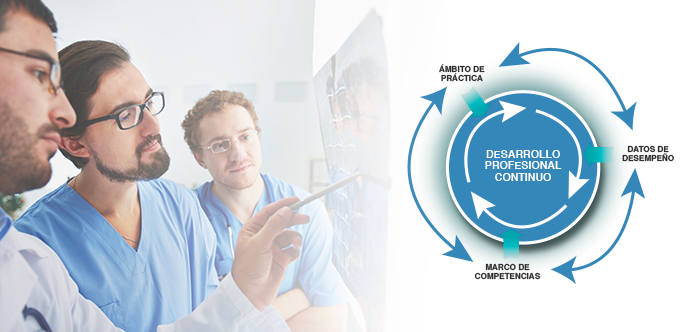
It is time to embrace professional development based on competencies. At least, that is what the recent literature suggests about continuing medical education. The transition will require professionals to evaluate their clinical performance, medical centers to provide indicators on a regular basis and train educators, and regulatory authorities to turn to the certification of competences throughout their professional careers.
Madrid – May 11, 2018. It is obvious that in a changing environment such as that of health sciences, learning should never stop. However, the traditional emphasis on interventions focused on vertical teaching and on the figure of medical experts is in question. Actually, the impact of this approach on medical performance and especially on the results of patient care has proved ineffective. That is, being up to date on clinical evidence does not necessarily translate into better professional behavior. Although the results of numerous studies published in recent years indicate that physicians who participate in formal activities of continuous professional development (CPD) are more likely to provide better care, it is noted that there are limitations around this passive learning. Competency-based training claims this space.
A 2015 investigation of CPD activities accredited in Canada showed that these activities were not designed to promote clinical behavioral changes, since they were aimed at memorizing information, rather than preparing physicians to analyze new data, contrasting evidence, and discriminating its relevance in clinical practice. Although they solve gaps in knowledge, these strategies are reductionist and blur a broader framework that would imply a more active role in consonance with the workplace and the promotion of the best professional standards. It is about moving from a system that simply requires demonstrating participation in vertical learning to a model based on competencies that demand feedback and a clear focus on results in response to the health needs of society. In short, it bets on the design of interactive, longitudinal programs based on practice.
Competency-based CPD is aimed at ensuring good clinical practice throughout the entire professional career and has to adapt to the times and opportunities for growth. Beyond entry into the profession, continuous development must be measured throughout the professional life, with special attention to any change that may be destabilizing, such as the introduction of new technology (which will require new skills), geographical relocation (which will require adaptation to a new environment), or the search for new professional horizons. It is when seeing new needs for adaptation and development, where competency-based CPD displays its potential. While expectations may vary from one country to another, their core remains: ensuring that physicians can demonstrate their commitment to lifelong learning through continuous assessment of savoir faire.
The collection of data in the workplace itself will help physicians know if they are prepared to pay attention to a specific area. At the same time, it offers them a mirror to compare themselves with other colleagues and urges to create an improvement plan while bringing to light unperceived needs. We are talking about graphic audits, monitoring of prescription programs, repository of population health indicators, feedback from different sources, simulation and direct observation of performance, and results reported by patients, among others. Learning in situ is imperative.
Even more, the proposal must be integrated into the health care system, oriented to the patient's results, guided by multiple indicators of performance and results, and supported by teamwork or interprofessional collaboration. All of this, in a joint effort of physicians, CPD providers, regulatory authorities, and the health system itself to implement the principles and strategies of the Anglo-Saxon philosophy of quality management. The key lies in the ability to join an iterative cycle of learning in which the scope of practice, performance data, and the competency framework are interrelated. The scope of practice identifies specific needs, the performance data provide information for permanent assessment, and the competency framework defines the compendium of essential skills for successful development.
Feedback and relevance
Traditional didactics in medical education are insufficient to induce changes in behavior and in the health system in general. The learning activities designed for small groups with a regular periodicity make an approach that has proved especially relevant. For family physicians, this work, guided by a facilitator who helps the group to be fully employed in cases based on practice and closely linked to scientific evidence, has proved very positive. The same happens with discussions and educational programs focused on physicians working together on a specific topic, such as tumor panels. Again, the same with self-directed learning, which allows professionals to track their environment to look for new windows of growth, evidence integrated into practice guides, and uses discarded as ineffective.
Asking and responding to oneself is a form of personal and professional growth and in this task, the simulation takes the lead. This is a very useful method in the medical-academic field, both for pedagogical and evaluative purposes. On the one hand, it facilitates the student's learning process and eliminates many of the collateral discomforts with patients and health services; and on the other hand, it evaluates the ability to search and interpret data and clinical examinations, the identification of health problems, the judgment about the treatment to be followed, and the practical knowledge and professional skills. The simulation allows to determine the degree of clinical competence acquired by the physicians, to train their clinical reasoning, and to evaluate the effectiveness of the study plans, among other advantages.
References
Jocelyn Lockyer, Ford Bursey, Denyse Richardson, Jason R. Frank, Linda Snell, Craig Campbell & on behalf of the ICBME Collaborators (2017) Competency-based medical education and continuing professional development: A conceptualization for change, Medical Teacher, 39:6, 617-622. doi: 10.1080/0142159X.2017.1315064
Sargeant, J. , Wong, B. M. and Campbell, C. M. (2018), CPD of the future: a partnership between quality improvement and competency‐based education. Med Educ, 52: 125-135. doi:10.1111/medu.13407
Our personalized help center enables you to obtain technical support and help for navigating through the site and using the program.